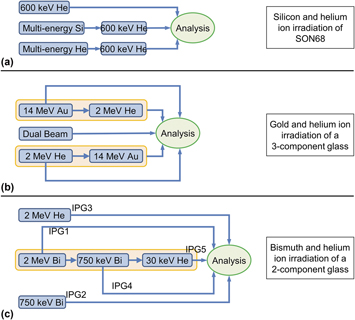Published online by Cambridge University Press: 08 March 2019

Highly radioactive waste is incorporated into a glass matrix to convert it into a safe, passive form suitable for long-term storage and disposal. It is currently known that alpha decay can generate gaseous species, which can nucleate into bubbles, either through the production of helium or from ballistic collisions with the glass network that liberate oxygen. An effective method to probe this phenomenon utilizes ion beams to either directly implant helium or investigate the damage due to ballistic collisions. This paper provides an overview of the methodology, summarizes the results of current studies, and draws comparisons between them. We find that the irradiation scheme as well as the temperature and composition of the glass are important in determining whether bubble formation will occur. We also explore how analytical techniques can promote bubble formation and suggest avenues for further work.
This section of Journal of Materials Research is reserved for papers that are reviews of literature in a given area.